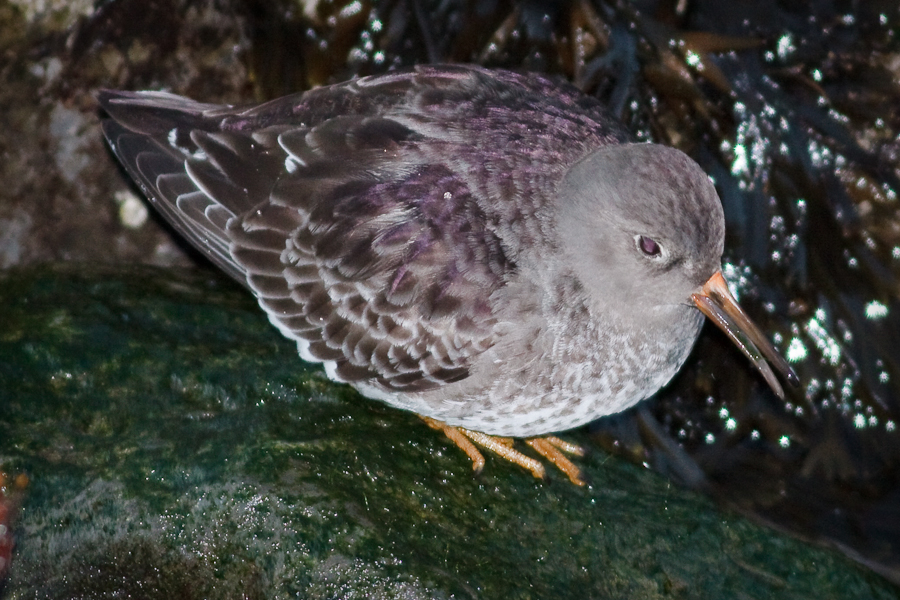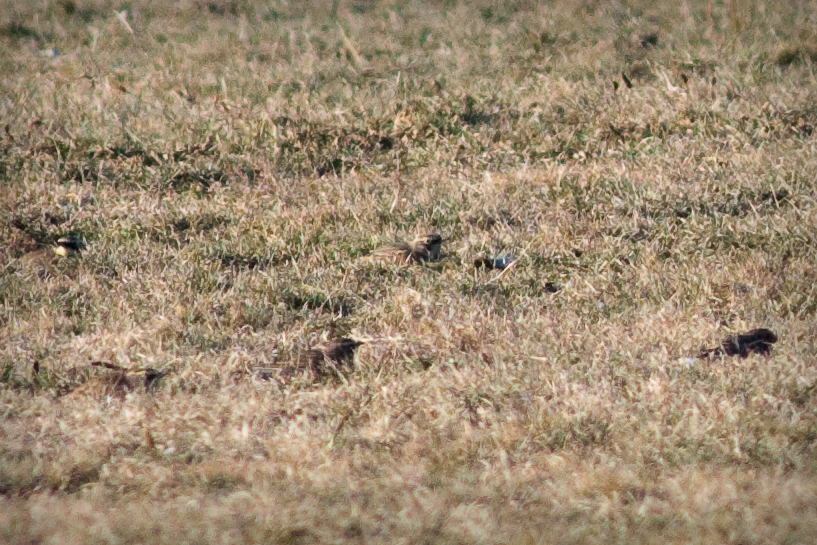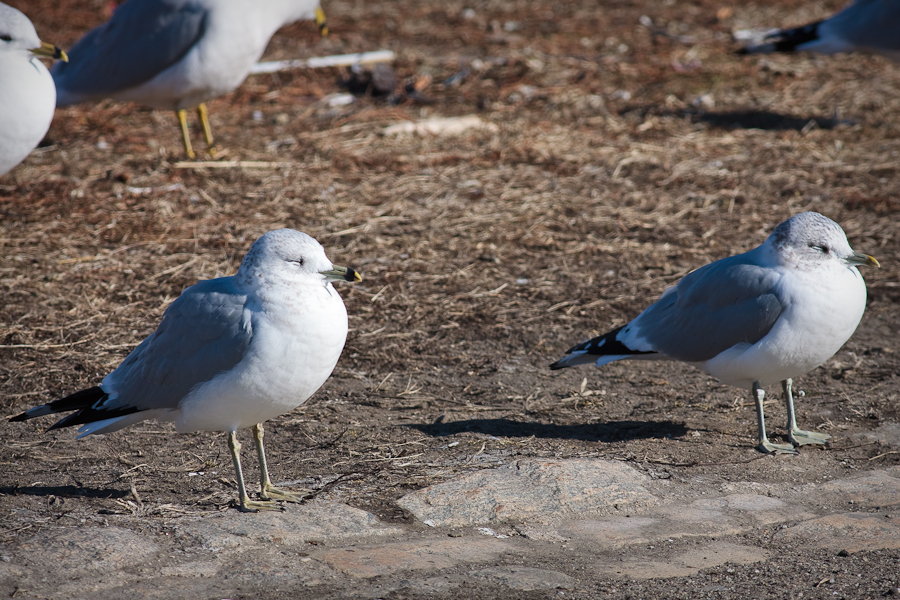#477 Lapland Longspur
Sunday morning I got up bright and early–well, at least early; it was before dawn–to chase a couple of rarities that have showed up in Brooklyn. The rarest was the Common Gull that Shane Blodgett first found in Gravesend Bay a couple of weeks ago. I’ve seen this bird before in Europe but never in the United States. A Mew Gull–the Pacific subspecies–showed up at San Joaquin Wildlife Sanctuary while I was living in Irvine last year, but I was never able to find it. The other target was a Lapland Longspur that Rob Jett found on the cricket field at Floyd Bennett Field last Saturday.
I arrived at Bay 16th St. shortly after dawn, and walked across the pedestrian bridge over the Belt Parkway to the bike path that follows the curve of the bay. The temperature was several degrees below freezing and the wind off the bay, while not as bad as it sometimes is, certainly didn’t help matters. I was hoping to quickly find the bird on the grass along the bike path where it had been seen the previous day and several times earlier, but no such luck. A couple of dozen gulls were flying over the bay, but even if a Common Gull were one of them it would be extremely hard to distinguish in this light at that distance. The Common Gull is very similar to a Ring-billed Gull. It’s about an inch smaller and does not show an obvious ring around the bill. Also, the legs are gray instead of dirty yellow, the eye is black instead of yellow, and there is a little more white along the base of the mantle. Exactly none of these field marks are obvious on a flying bird 20 meters away.
I walked up and down along the path waiting for some gulls to come in closer where I might have a chance at picking out a Common Gull. I saw what looked like a couple of fairly large shorebirds fly up the rocks. Heading up the way they proved to be Purple Sandpipers, the closest I’ve ever seen. I had a great deal of trouble finding these a few years ago, and now here they were right in front of me. Unfortunately they weren’t the bird I was looking for today.

I ran into a couple of other birders who had come to look for the gull, and showed them the Purples, and then we hunkered down to wait for the gull. Gulls flew in and out, but no Common Gull. I lasted another hour until about 8:30 when the cold just got too much for me. Since there didn’t seem to be a lot of action happening here, we traded cell phone numbers in case it showed up and I drove over to the end of Bay Parkway where the gull had first been spotted. It looked promising, especially when I realized there was someone from a bakery feeding a large box of stale bread to the rampant gull flock, but although there were numerous Ring-billed Gulls and not a few Rock Pigeons, that was all. The common gull was not to be found here either, at least not this morning.
I continued on to Floyd Bennett Field. I expected to be paged that the gull had appeared as soon as I got on the Belt Parkway, but no such luck. I got to Floyd Bennett Field at 9:00 and drove straight to the cricket field. Sure enough, there were about 20 Eastern Meadowlarks grazing not far from the sidewalk. Was one of them a Longspur? With binoculars I really couldn’t tell, so I went back to the car and got my scope, then carefully walked back, trying not to spook them. Scoping the flock, there was one that didn’t look quite right. It had a lot less yellow than a Meadowlark does, but these were very small birds very far away in grass that, though cut, was almost as tall as they were. How to be sure? I eventually got reasonably confident that it wasn’t a meadowlark, because I could always relocate it amongst the meadowlarks, and although it showed more yellow than I was expecting it didn’t come close to the bright yellow of the meadowlarks.

Sometimes a meadowlark would turn away and not look so lemon yellow, but invariably after it kinked its head back again and especially when it looked straight at you, you’d immediately see a huge splash of yellow. This bird never had that, just a light wash of waxy yellow on only part of its face. And the more I looked at it the more I realized that in profile the facial pattern was different than the meadowlark’s too. This bird had a sort of brown, triangular outline around its face. Bingo. That’s a Longspur. Now which one? Probably a birder with a more experience of Longspurs could have just eyeballed this one, but I haven’t seen but a couple in my life so I needed to be careful and check the field marks and the field guide. Lapland is the most common species around here, but Smith’s and Chestnut-collared are not impossible.
For that I had to go to the back and belly (and consult the field guide again. The belly was a little hard to make out in the grass, but eventually it spent enough time in shorter grass to make it apparent that the belly was white, which ruled out Smith’s. The overall color and patterning on the back looked a lot more like the brighter Lapland than the dull (at this time of year) Chestnut-collared. There it was. #477. I then tried for some better photographs but got nothing more than what you see above, that may not even have the bird in the frame. It was just too far away and too small for my 400mm lens. The scope was necessary. I could not have found this bird with binoculars alone. Shortly after this, the flock left and headed out for wherever they spend the rest of their day. But my day wasn’t over yet.
My cell phone had not yet rung so I figured I had a little bit more time to explore Floyd Bennett Field. I spent a little time in the community gardens, and out along the bay at the end of the archery road and runway 2. I wasn’t really expecting to find anything spectacular. Mostly I just wanted to compare my results with the Canon 400 mm f/5.6L lens to the photographs I had taken at the same location a few weeks earlier with the 300 mm f/4L lens. Short answer: the 400 mm lens is much superior to the 300 mm lens despite the lack of image stabilization. Partially it’s the extra reach, and partially it’s just that it’s a much sharper lens. A few my photographer friends have expressed some surprise that these results and suggested that perhaps I just had a bad copy of the 300 mm lens. That may be so, but if it is, then there’s a real quality control problems at the factory. Certainly, I’ve seen some amazing photographs taken with the 300 mm lens that go way beyond anything I was ever able to achieve with it. I found the 400 mm lens much easier to work with. But enough about cameras. Let’s get back to birds.
I left Floyd Bennett Field about 10:30 and returned to Bay 16th Street for another try at the Common Gull. When I arrived, the bird had still not yet been seen that day. However, shortly after I got there, someone rode up on a bicycle and told us that the bird had been spotted north of us about a mile at the first parking lot past the Verrazano Narrows Bridge. So we all grabbed our scopes and trotted up there. Sure enough, there was a large flock of several hundred goals on the grass near the parking lot. We scoped it repeatedly, spotted one tagged gull, and even chummed the gulls with some bread. No luck. It took a while, but we eventually convinced ourselves that even if the bird had been there, it wasn’t there any longer. Somewhat dejectedly we walked back down to Bay 16th St. Along the way, we heard that the Common Gull had been seen for about half an hour right by the pedestrian overpass where we had started. I let out more than a few choice words. By the time we got back to Bay 16th St., the bird had departed again. This time, however, there were photographs to prove that the bird had indeed been there; and we’d missed it. Fuck.
By now it was almost noon, and I was more than a little hungry. Based on past reports the gull seemed to space its appearances out by an hour or more so I figured it was a reasonably safe time to decamp for lunch. Fortunately I was right. by the time I returned 45 minutes later, the bird had still not been seen again. Although the weather was not quite as bone chilling as it had been at 7 AM, it was still below freezing, and I wasn’t sure how much more of this I could take. I chatted with a couple of the birders from upstate who driven down to look for the gull and who had been somewhat more diligent than me in sticking with the spot. They still haven’t seen the bird either. At least I didn’t miss it while I ate lunch. That would have been too much.
We casually inspected the several dozen Ring-billed Gulls standing on the grass. No Common Gull. We chatted. We checked the gull flock. We chatted. We checked the gull flock. We chatted. We checked the gull flock. This went on for about 10 or 15 minutes. Then suddenly one of the upstaters says, “there’s the bird.” We had no idea where it came from. We hadn’t seen any bird fly in. At first, I couldn’t see the bird but they put me on it quickly. Once I saw it, it was obvious. It was a little smaller, but far more obviously the legs were gray instead of yellow and the bill didn’t have any black ring:

(In case it isn’t so obvious the Common Gull is on the right.)
Still, this is not exactly a bird would jump out at you as different if you were barreling along the bike path at 20 mph. In fact, you’d have to be looking pretty carefully to notice anything different at all. the bird hung out for about 10 minutes before passing car tossed out some litter and attracted the flock to the other side of the pedestrian overpass. In the confusion, the Common Gull took off and likely headed out across the bay somewhere.
Still, as life bird sightings go it was pretty convincing. Or at least it was until I got home and checked my records. I have been saying that this is my first to life bird day in Brooklyn in several years. But when I look at my official life list, I realized I had already seen Common Gull in Europe before. I had missed it previously because I was looking for Mew Gull, which I still haven’t seen. However Mew Gull and Common Gull are different subspecies of the same species, Larus canus. Common Gull is Larus canus canus and Mew Gull is Larus canus brachyrhynchus. Besides location, the subspecies differ mainly in how dark the matle is and how much black is present on the wingtips. These details I leave to the experts. Nonetheless, it was still an AOU area bird, a state bird, a North American bird, and a Kings County bird. That’s worth a few hours in the cold.

